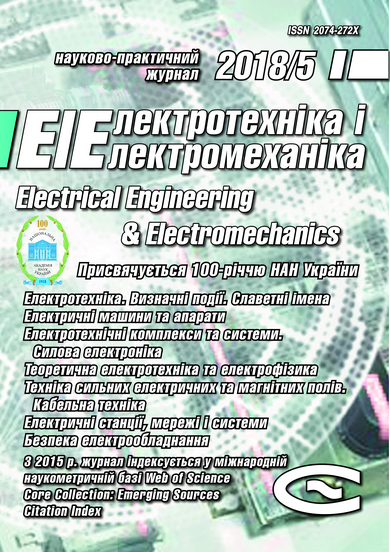ON THE ISSUE OF DESIGN OF GROUNDING SYSTEMS OF 330(220) KV SUBSTATIONS TO ENSURE THE ELECTROMAGNETIC COMPATIBILITY OF SECONDARY CIRCUITS
DOI:
https://doi.org/10.20998/2074-272X.2018.5.11Keywords:
grounding system, substations, electromagnetic compatibility, secondary circuits, grounding system resistanceAbstract
Purpose. The purpose of the work is to develop the fundamentals of the design methodology of grounding system design of substations with open switchgears 330 (220) kV, which is aimed at ensuring electromagnetic compatibility of secondary circuits of current transformers. Methodology. To carry out the research, the provisions of the theory of experiment planning, the theory of electrical circuits, mathematical modeling in the package Grounding 1.0 and Microsoft Excel were used. Results. During the one-factor experiments, the dependencies of the grounding system resistance and the voltage between the calculated points on the grounding system area, the size of the grid cell, the perimeter of the grounding system horizontal electrodes cross-section, the equivalent soil resistivity, the short-circuit current and the design factor were obtained. It is shown that the grounding system resistance and the voltage between the calculated points are practically independent of the depth of the horizontal electrodes in the depth range from 0.4 m to 1.4 m. Originality. The paper formulated three criteria for grounding system designing of substations 330 (220) kV, aimed at ensuring electromagnetic compatibility of secondary circuits. Practical value. The fundamentals of the methodology for grounding system designing are formulated according to the criterion of preventing false triggering of relay protections in emergency modes.References
1. Pravila ulashtuvannya electroustanovok [Electrical installation regulations]. Kharkiv, Fort Publ., 2017. 760 p. (Ukr).
2. Rudenko S.S., Koliushko D.G., Kashcheyev O.V. Determination of direction to reconstruction of grounding system. Electrical engineering & electromechanics, 2017, no.2, pp. 57-61. (Ukr). doi: 10.20998/2074-272X.2017.2.09.
3. IEC/TS 61000-6-5 Electromagnetic compatibility (EMC) – Part 6-5: Generic standards – Immunity for power station and substation environments.
4. Voronina Z.A., Glebov O.Yu., Koliushko G.M. Determination of the levels of electromagnetic interference in the cables of current transformers with short-circuit on substation buses in order to ensure electromagnetic compatibility. Bulletin of NTU «KhPІ», 2011, no.16, pp. 44-59. (Rus).
5. Baranov M.I. Zabezpechennya enerhetychnoyi bezpeky Ukrayiny shlyakhom pidvyshchennya nadiynosti roboty stratehichnykh enerhoobyektiv v normalnomu ta avariynykh rezhymakh. Zvit pro NDR (promigny; № derzhreyestratsiyi 0117U000534) [Ukraine's energy security by increasing the reliability of the operation of strategic energy facilities in normal and emergency modes. Report on research work. State registration no.0117U000534)]. Kharkiv, NTU «KhPI» Publ., 2017. (Ukr).
6. STO 56947007-29.240.044-2010. Metodicheskie ukazanija po obespecheniju elektromagnitnoj sovmestimosti na ob'ektah elektros-etevogo hozjajstva [Methodical instructions on ensuring electromagnetic compatibility on objects of electronetwork economy]. Moscow, JSC FGC UES Publ., 2010. 147 p. (Rus).
7. Burgsdorf V.V., Yakobs A.I. Zazemlyayushchie ustroystva elektroustanovok [Grounding device of electrical installations].Moscow, Energoatomizdat Publ., 1987. 400 p. (Rus).
8. Koliushko D.G. The interface of the program complex for Grounding system calculating of electric power objects. Bulletin of NTU «KhPІ», 2007, no.34, pp. 71-79. (Rus).
9. Link I.Yu., Koliushko D.G., Koliushko G.M. A mathematical model is not an equipotential ground grids substation placed in a double layer. Electronic modeling, 2003, vol.25, no.2, pp. 99-111. (Rus).
10. Nayfeld N.R. Zazemleniye, zashchitnyye mery elektrobezopasnosti. [Earthing, protective measures of electro-safety] Moscow, Energiya Publ., 1971. 312 p. (Rus).
Downloads
Published
How to Cite
Issue
Section
License
Copyright (c) 2018 O. Yu. Glebov, D. G. Koliushko, G. M. Koliushko, E. P. Eremeeva

This work is licensed under a Creative Commons Attribution-NonCommercial 4.0 International License.
Authors who publish with this journal agree to the following terms:
1. Authors retain copyright and grant the journal right of first publication with the work simultaneously licensed under a Creative Commons Attribution License that allows others to share the work with an acknowledgement of the work's authorship and initial publication in this journal.
2. Authors are able to enter into separate, additional contractual arrangements for the non-exclusive distribution of the journal's published version of the work (e.g., post it to an institutional repository or publish it in a book), with an acknowledgement of its initial publication in this journal.
3. Authors are permitted and encouraged to post their work online (e.g., in institutional repositories or on their website) prior to and during the submission process, as it can lead to productive exchanges, as well as earlier and greater citation of published work.





